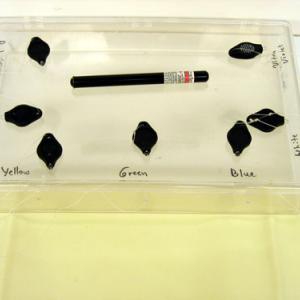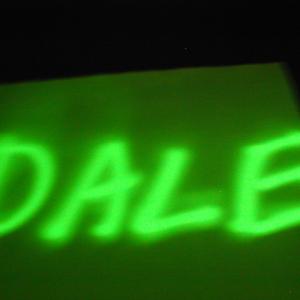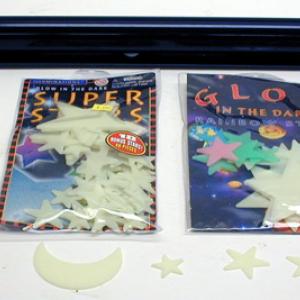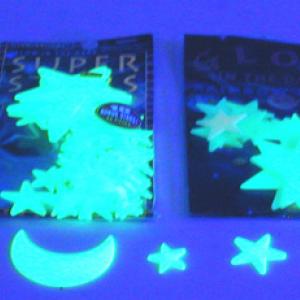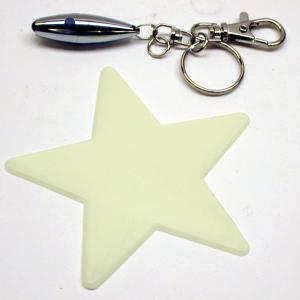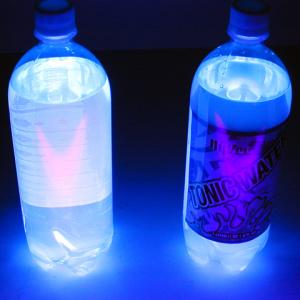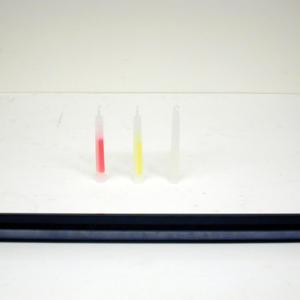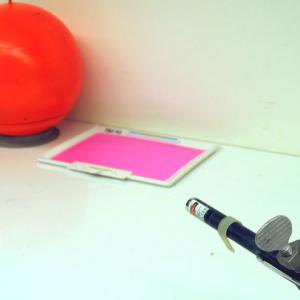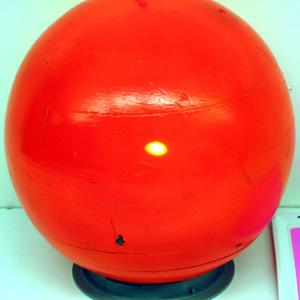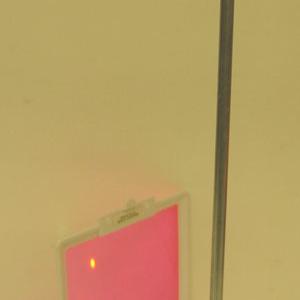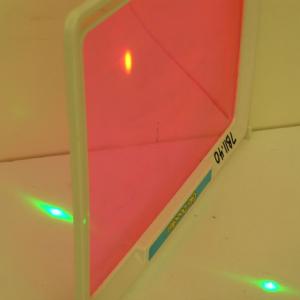College of Liberal Arts & Sciences
7B13.55 - Luminescence & UV - Glow in the Dark Materials & Black Light
The LED lights come in different colors. You can show that the black light material will not be activated unless you have light with wavelengths approaching the ultraviolet. Even a laser pointer will not activate the black light material.
Lay out the desired black light materials. Activate with the black light wand, shut off the lights and observe the luminescent glow.
The key chain light is actually an ultraviolet LED. This may be used to write names or illuminate certain portions of the black light sheets and materials.
Tonic water contains quinine which will fluoresce under black light.
Light sticks contain fluorescent materials. Place an un-activated light stick under the black light and observe.
If you point a green laser pointer at a fluorescent orange object, the spot will be yellow. You can go one step beyond this and shine the green laser pointer at a steep angle onto the glow doodler. The spot on the glow doodler will be yellow, but the input, transmitted, and reflected beams will all be green.
- Aleš Mohorič, "Simple Demonstration of a Phosphorescence in a Fluorescent Lamp by Camera Panning", TPT, Vol. 56, #4, Apr. 2018, p. 260.
- Jennifer J. Birriel and Damon King, "Fluorescence Spectra of Highlighter Inks", TPT, Vol. 56, #1, Jan 2018, p. 20.
- Jennifer J. Birriel, "Fluorescent Tonic Water", TPT, Vol. 55, #2, Feb. 2017, p. 128.
- Gorazd Planinšič, "Fluorescence and Phosphorescence: Easier to Investigate than to Spell", TPT, Vol. 54, #7, Oct. 2016, p. 442.
- Jennifer Birriel, "Birriel's Response", TPT, Vol. 54, #1, Jan. 2016, p. 4.
- David Headly, "Absorption or Reflection?", TPT, Vol. 54, #1, Jan. 2016, p. 4.
- Jennifer J. Birriel and Clarissa Roe, "Demonstrating Fluorescence with Neon Paper and Plastic", TPT, Vol. 53, #6, Sept. 2015, p. 328.
- Wen-Tang Lee and Richard Chin-Wei Chang, "Another Colorful Conundrum", TPT, Vol. 52, #8, Nov. 2014, p. 504.
- Matt Lowry, "Colorful Conundrum", TPT, Vol. 44, #7, Oct. 2006, p. 474.
- Gordon R. Gore, "Black Light and Light Sticks", TPT, Vol. 43, #3, Mar. 2005, p. 184.
- Lawrence T. Escalada, N. Sanjay Rebello, and Dean A. Zollman, "Student Explorations of Quantum Effects in LEDs and Luminescent Devices", TPT, Vol. 42, #3, Mar. 2004, p. 173.
- J. David Gavenda, "On 'Sunscreens and the Photoelectric Effec't", TPT, Vol. 36, #3, Mar. 1998, p. 132.
- Richard Bartels and Fred Loxsom, "The Sun-Protection Factors of Wet and Dry T-Shirts", TPT, Vol. 36, #2, Feb. 1998, p. 86.
- Michael Grote and William Heinmiller, "Sunscreens and the Photoelectric Effect", TPT, Vol. 34, #9, Dec. 1996, p. 549.
- Richard Bartels and Fred Loxsom, "Can You Get a Sunburn Through Glass?", TPT, Vol. 33, #7, Oct. 1995, p. 466.
- Tom Donohue and Howard Wallace, "Ultraviolet Viewer", TPT, Vol. 31, #1, Jan. 1993, p. 41.
- Salvatore Ganci, "The Standing Wave Pattern of a String in Fluorescent Light", AJP, Vol. 52, #3, Mar. 1984, p. 250.
- Richard J. Fitzgerald, "Frog Fluorescence", Physics Today, Vol. 70, #5, May 2017, p. 23.
- J. S. Prener and D. B. Sullenger, "Phosphors", Scientific American, Vol. 191, #4, Oct. 1954, p. 62 - 66.
- "Bonus: Glowing Hands", 50 Fun Experiments for the Mad Scientist in You, National Geographic Kids, p. 74.
- "Highlighted Water", 50 Fun Experiments for the Mad Scientist in You, National Geographic Kids", p. 72 - 73.
- Martin C. Sagendorf, "43. What You Can't See - Ultra-Violet", Physics Demonstration Apparatus, 2009. p. 132 - 133.
- George M. Hopkins, "Chemical Thermoscope, Hygroscopic and Luminous Roses", Experimental S.cience, p. 198 - 199.
- Don Rathjen and Paul Doherty, "Shadow Panel", Square Wheels, 2002, p. 93 - 95.
- Borislaw Bilash II and David Maiullo, "Physics 'Phriendship' Bracelets", A Demo a Day: A Year of Physics Demonstrations, p. 358.
- Jearl Walker, "6.137, Whiter than White", The Flying Circus of Physics Ed. 2, p. 300.
- Jearl Walker, "6.134, Twinkies and Vaseline Parties", The Flying Circus of Physics Ed. 2, p. 299.
- Jearl Walker, "5.19, Wintergreen Glow in the Street", The Flying Circus of Physics Ed. 2, p. 227.
- Julien Clinton Sprott, "6.8, Fluorescence", Physics Demonstrations, ISBN 0-299-21580-6, p. 251 - 252.
- Yaakov Kraftmakher, "4.10, Photoluminescence", Experiments and Demonstrations in Physics, ISBN 981-256-602-3, p. 282 - 286.
- Ron Hipschman, "Recipe No. 132: Stored Light", Exploratorium Cookbook II, 1980.
- T. D. Rossing and C. J. Chiaverina, "13. Fluorescence of Tonic Water", Light Science, Physics and Visual Arts, 1999, p. 150.
- 1998 Educational Innovations Catalog, "A Super Demo in the Dark!", p. 35.
- Brian Jones and Matt Fackelman, "Frozen Shadows", Don't Forget the Duct Tape, p. 53 - 56.
- Don Rathjen, Paul Doherty, and the Exploratorium Teacher Institute, "Shadow Panel", Square Wheels, 2002, p. 93 - 95.
- Mary V. Frohne, Handy Self-Contained E=hf Demonstrator; Nov 8, 2001.
- Kansas State University, "Modeling Light Emission to Explain Phosphorescence", Visual Quantum Mechanics The Next Generation", 2001.
Disclaimer: These demonstrations are provided only for illustrative use by persons affiliated with The University of Iowa and only under the direction of a trained instructor or physicist. The University of Iowa is not responsible for demonstrations performed by those using their own equipment or who choose to use this reference material for their own purpose. The demonstrations included here are within the public domain and can be found in materials contained in libraries, bookstores, and through electronic sources. Performing all or any portion of any of these demonstrations, with or without revisions not depicted here entails inherent risks. These risks include, without limitation, bodily injury (and possibly death), including risks to health that may be temporary or permanent and that may exacerbate a pre-existing medical condition; and property loss or damage. Anyone performing any part of these demonstrations, even with revisions, knowingly and voluntarily assumes all risks associated with them.
